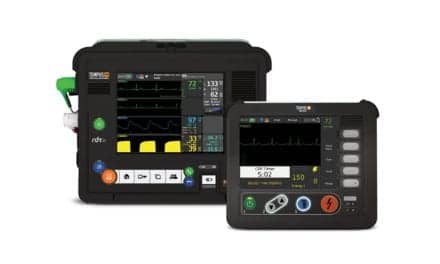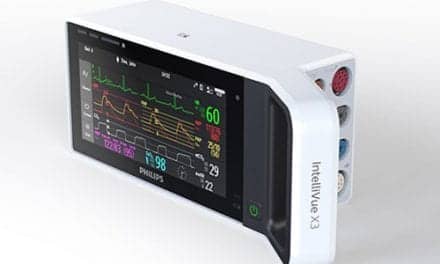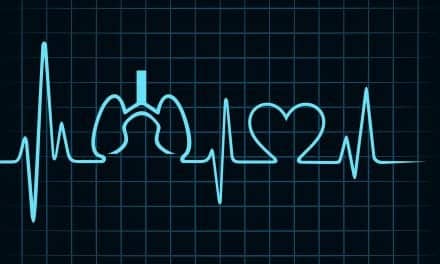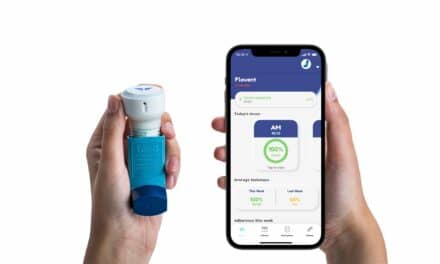By Phyllis Hanlon

Paul Jansen, executive vice president of marketing and clinical development at Masimo in Irvine, Calif, noted that the earliest pulse oximeters, which were unwieldy and expensive, focused on ear placement and were unable to provide absolute values and were not used clinically. The introduction of the “pulse” oximeter in the 1980s brought peripheral oxygen saturation (SpO2) into medical venues as a standard of care; however, these devices still had limitations, specifically related to inability to obtain readings and false desaturation readings during motion and low perfusion conditions.
In 1996, Masimo introduced pulse oximetry based on Signal Extraction Technology (SET). The company used advanced signal processing techniques, including parallel engines and adaptive filters, to separate the arterial signal from the nonarterial noise such as the venous blood movement during motion. The result was the first pulse oximetry technology able to measure accurately during challenging conditions of patient motion and low perfusion, which dramatically reduced false alarms.
“SET pulse oximetry also led to the reduction of retinopathy of prematurity by helping clinicians prevent overtitration of oxygen in the NICU. Another good example is the use of SET in screening newborns for critical congenital heart disease (CCHD), and using SET to decrease ventilator weaning times in the ICU. Most recently, SET has been used to monitor oxygenation on the general floor, which was previously plagued by so many false alarms, and shown to reduce rescue activations and ICU transfers while saving hospitals money,” said Jansen.
By the late 1990s, handheld, stand-alone, and integrated multiple parameter pulse oximeters populated most clinical settings, and basic models could be found in the home. “Respiratory therapists can now detect clinically significant changes in oxygenation with reliability and accuracy, and that’s led to what we believe are improvements in the process of care. When RTs need to assess and make oxygen therapy or ventilator setting changes, pulse oximetry is an especially important tool and the accuracy of the measurements during challenging conditions is paramount,” Jansen said.
Somewhat similar to pulse oximeters, multi-wavelength pulse CO-oximeters provide noninvasive, continuous monitoring of blood constituents that previously required invasive or complicated procedures, such as total hemoglobin (SpHb), carboxyhemoglobin (SpCO), and methemoglobin (SpMet), as well as measuring SpO2 and pulse rate. Jansen noted that SET pulse oximeters also have the ability to detect fluid responsiveness in a manner similar to pulse pressure variation from an invasive catheter. “This is a major advancement. It allows noninvasive and continuous assessment and helps with decisions about whether to provide fluid to critically ill patients,” he said.
Special Populations
At La Rabida Children’s Hospital in Chicago, a transitional hospital that serves children from birth to age 19 who have chronic illnesses, pulse oximetry is used on a regular basis, according to Linda Robinson, BS, RRT, respiratory manager. “Our hospital errs on the side of safety and uses pulse oximetry more than the average facility. Some of our patients are on continuous pulse oximetry,” she said. Given the fragility of its patient population, La Rabida prefers noninvasive monitoring over other methods due to the convenience, ease of use, portability, rapid response time, and reduced risk of infection, noted Robinson.
Unlike adults, newborns and babies have better blood flow in their feet, which is usually where therapists affix the probe. “For older kids, we place the probe on the finger. If it’s difficult to pick up a reading, we place the probe on the head. Perfusion to the brain is very accurate,” Robinson said. “But this is not recommended for babies.”
Working with children can present some challenges, Robinson admitted. Active youngsters can dislodge probes, in which case the therapist may opt to wrap the probe around the entire hand for stability. Certain clinical conditions also can impede accurate readings. For instance, peripheral vascular disease negatively affects blood flow so a therapist would have to find an alternative monitoring method. Also, someone with carbon monoxide poisoning might give a reading of 100%, which, Robinson pointed out, does not actually reflect oxygen levels. “Blood has a strong affinity to carbon monoxide. You would never use an oximeter in this case,” she said.
Although oximeters are indispensable for monitoring purposes, Robinson found that some staff rely too heavily on the device exclusively. “Some people depend on it for exact numbers, but the probe may not be on properly or the fingers could be cold,” she said. “You have to correlate the numbers with visual assessment and vital signs. Never trust the pulse oximeter by itself.”
La Rabida currently uses a basic model oximeter in most cases, but the hospital has been exploring a newer type that picks up sonar waves, said Robinson. “It’s supposed to be more accurate and gives you more information.”
Assessment Tool
Pulse oximetry is also used widely at Mercy Medical Center in Baltimore for all patients, regardless of age, illness, or condition. “Respiratory therapists use it to gauge how well a treatment is working or is appropriate. It’s an assessment tool,” said Kim Griffin, BS, CRTT. “Pulse oximetry is in continuous use in the ICU, NICU, emergency room, and recovery. It’s a built-in monitoring system and is also used continuously for medical procedures in the operating room. This has become standard and is used throughout the hospital. It gives us a quick snapshot of a patient’s oxygenation status.”
Mercy Medical uses two types of pulse oximeters: a hard-shell clip sensor that molds to the finger and is used multiple times, and a single-patient, disposable wrap-type sensor. Griffin explained that the former is easily cleaned with bleach wipes, and the latter is standard for long-term use and changed as needed every 3 or 4 days.
Although studies do not support the theory, Griffin offered anecdotal evidence that oximeters often produce sporadic, questionable readings on patients wearing nail polish. For that reason, the supply carts contain pads soaked in nail polish remover. Also, patients with pressure sores on their fingers or ears, burns, skin discoloration, and darker pigment in their skin may skew the readings and require alternative monitoring methods.
However, respiratory therapists at Mercy Medical unanimously prefer oximetry. “Without pulse oximetry, we would have to do an invasive procedure such as a blood gas, which requires the patient to have multiple arm sticks. Or we would have to insert an arterial line for repeated blood gas readings. We would have to repeat the blood gas as we made changes on ventilations and settings. [Oximetry] is a quick way to assess therapies,” said Griffin. “I was around when oximetry came ‘into fashion.’ It was something we called ‘magic.’”
Home Use
Although some professionals in the health care community are reluctant to accept the idea of at-home pulse oximetry, Scott D. Cerreta, BS, RRT, director of education for the COPD Foundation, supports the practice. “If we can teach people with diabetes to stick their finger, measure the blood sugar, and inject medication, we can teach a patient to put a probe on the finger and adjust their oxygen level,” said Cerreta.
Patients with chronic obstructive pulmonary disease (COPD), as well as those with acute respiratory infections such as pneumonia or influenza, can benefit from using pulse oximeters to monitor oxygen saturation and maintain appropriate oxygen levels, explained Cerreta. Portable, battery-operated devices with finger probes, similar to the ones found in sports shops for high-altitude climbers, provide a pulse oxygen rating and pulse reading and are easy to operate. “They don’t require a doctor’s prescription,” he said, adding that home models work best on patients with good circulation in their hands. “The hands should be warm and dry. Someone with wet, cold hands, who is fidgety or has poor circulation or a fistula, will get an inaccurate reading,” he said.
Pulse oximeters for home use vary in price from $50 to $250, depending on how many “bells and whistles” the device has. Batteries typically last 1 year and the machine itself should last a lifetime with proper care, Cerreta noted.
Cerreta emphasized that home pulse oximeters do not replace physician oversight or inpatient monitoring, but are to be used during stressful events, such as shortness of breath. Readings may fluctuate during activity and may indicate the need to adjust oxygen titration. Patients who obtain an acceptable reading while on oxygen, but still experience shortness of breath, should consult their physician. “The basic question [in this case] relates to ventilation and not oxygenation,” Cerreta said.
Although over-the-counter models are appropriate for spot checking saturation level and heart rate, Yvonne Leonard, group product manager for Nonin Medical, recommended that patients monitoring their oxygen saturation and heart rate at home use an oximeter that has been cleared by the FDA, which requires a prescription. “This is the best way to ensure that the product meets the standards needed for patient care. There is currently no over-the-counter approval for oximeters; therefore, an oximeter that does not require a prescription is not a medical device and is not regulated for accuracy or safety by the FDA,” she said.
“A reputable oximeter manufacturer will have testing data on file to support the accuracy claims they make for their products. They will tell you where the product is manufactured and provide information about the materials used in their product,” Leonard said. “Look for a manufacturer that provides live customer and technical support and stands behind their product with a warranty. Additionally, reputable manufacturers should be able to support clinicians and DMEs (durable medical equipment dealers) with patient education materials.”
While basic monitoring is relatively simple, some conditions may require more continuous monitoring and a patient or caregiver may need to be trained on setting alarms and correct sensor placement, Leonard pointed out.
Leonard suggested respiratory therapists and/or pulmonologists provide target SpO2 and heart rate readings and an action plan should patients fail to reach these levels. Patients should keep a regular log and use a wireless oximeter that can connect to a home-monitoring system.
While pulse oximeters can readily be found in clinical and home settings, some devices, such as Masimo’s new iSpO2, have bridged the technological divide. “The iSpO2 allows an iPhone, iPad, or iPod touch to be used to display SpO2, pulse rate, and perfusion index,” said Jansen. “It’s a mobile platform with external hardware and software that enables anyone to use pulse oximetry in more settings, in new ways.” RT
Phyllis Hanlon is a contributing writer for RT. For further information, contact [email protected].










